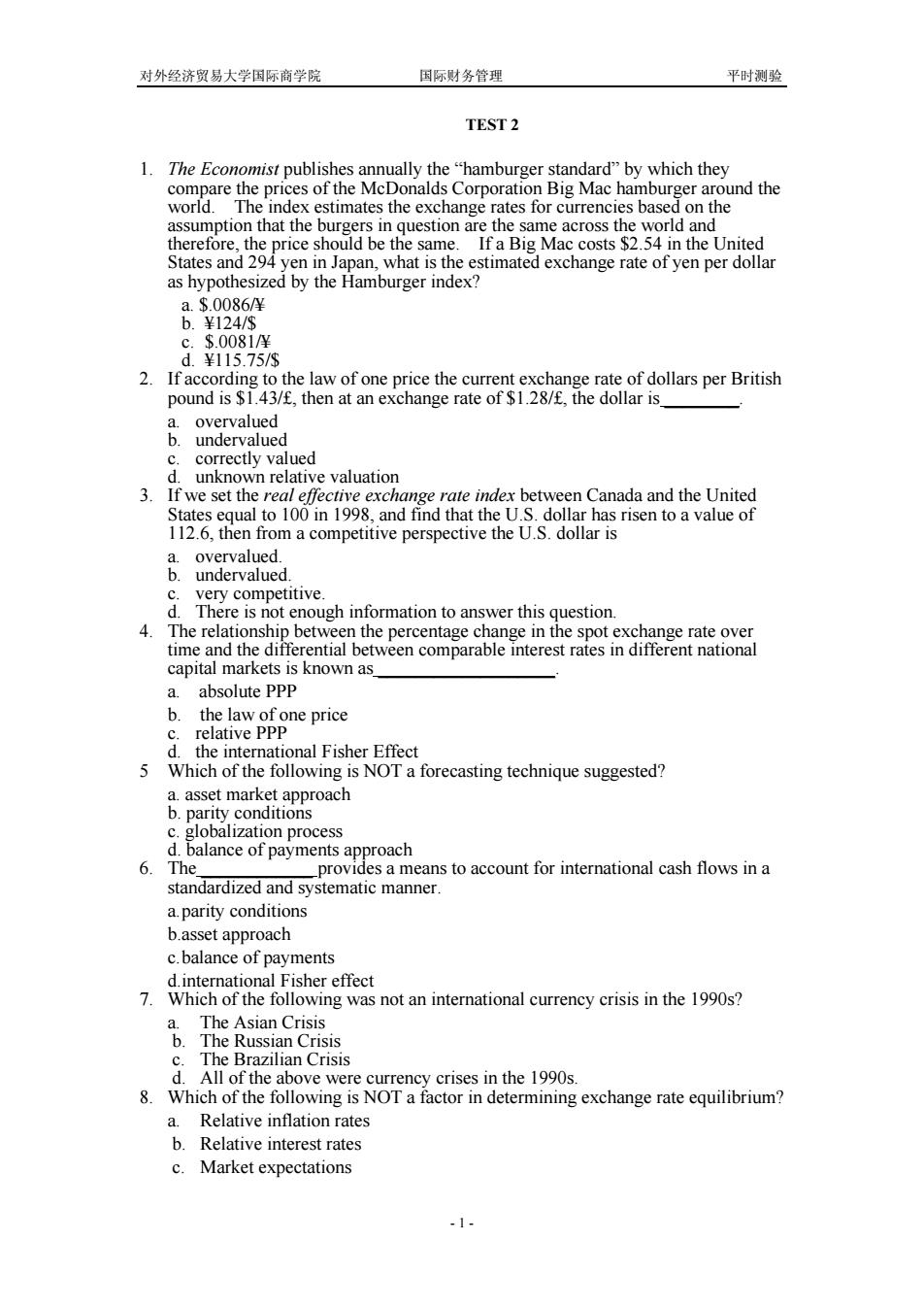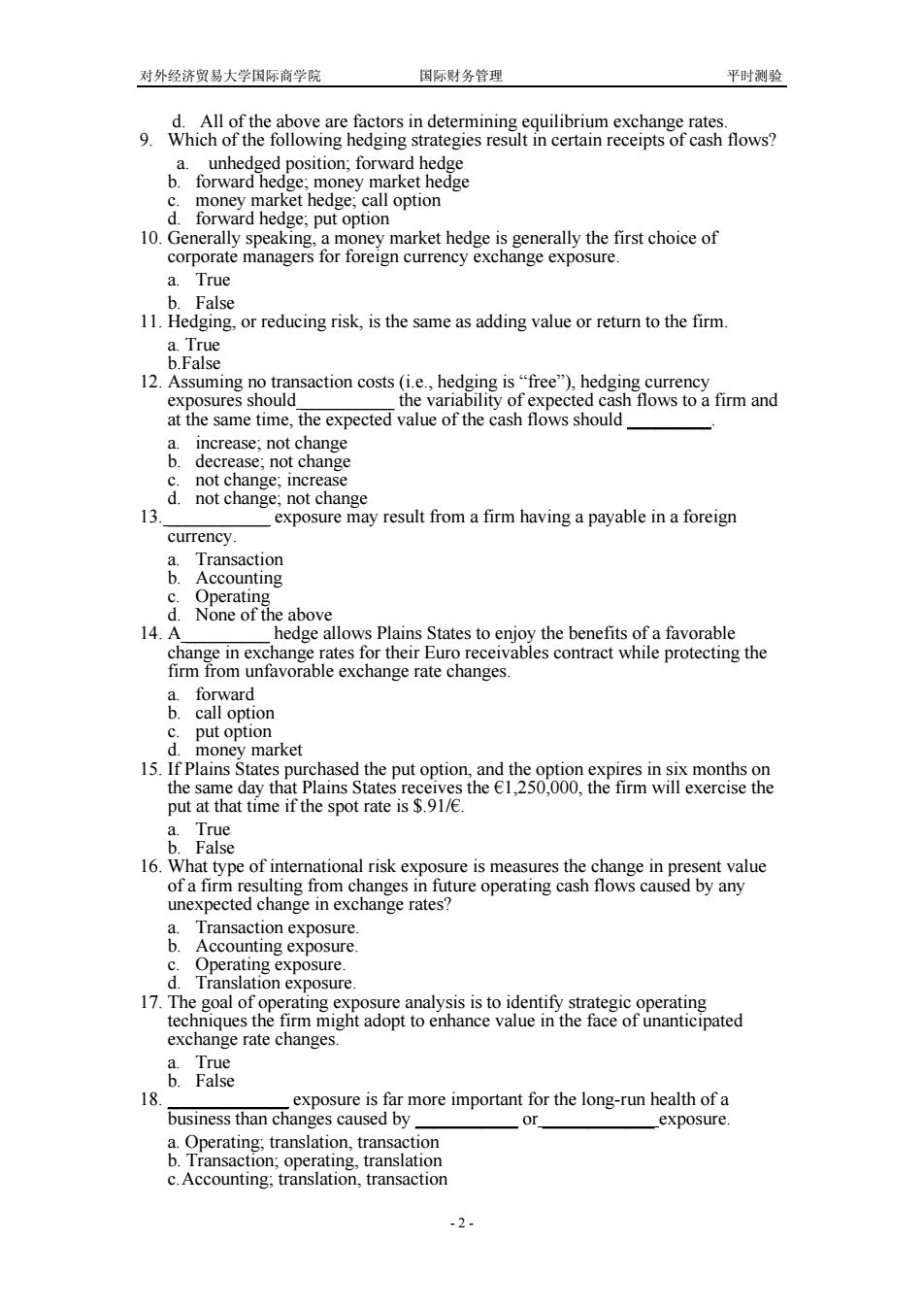
对外经济贸易大学国际商学院 国际财务管理 平时测验 TEST 2 1.The Economist publishes annually the "hamburger standard"by which they compare the prices of the McDonalds Corporation Big Mac hamburger around the world.The index estimates the exchange rates for currencies based on the assumption that the burgers in question are the same across the world and therefore,the price should be the same.If a Big Mac costs $2.54 in the United States and 294 yen in Japan,what is the estimated exchange rate of yen per dollar as hypothesized by the Hamburger index? a.$.0086/ b.¥124/$ c.$.0081¥ d.¥115.75/$ 2.If according to the law of one price the current exchange rate of dollars per British pound is $1.43/f,then at an exchange rate of $1.28/f,the dollar is a. overvalued b. undervalued C. correctly valued d. unknown relative valuation 3.If we set the real effective exchange rate index between Canada and the United States equal to 100 in 1998,and find that the U.S.dollar has risen to a value of 112.6,then from a competitive perspective the U.S.dollar is a.overvalued. b. undervalued C. very competitive. d.There is not enough information to answer this question. 4. The relationship between the percentage change in the spot exchange rate over time and the differential between comparable interest rates in different national capital markets is known as_ a. absolute PPP b the law of one price C. relative PPP d.the international Fisher Effect 5 Which of the following is NOT a forecasting technique suggested? a.asset market approach b.parity conditions c.globalization process d.balance of payments approach 6.The provides a means to account for international cash flows in a standardized and systematic manner. a.parity conditions b.asset approach c.balance of payments d.international Fisher effect 7.Which of the following was not an international currency crisis in the 1990s? a. The Asian Crisis b.The Russian Crisis c.The Brazilian Crisis d.All of the above were currency crises in the 1990s. 8.Which of the following is NOT a factor in determining exchange rate equilibrium? a. Relative inflation rates b.Relative interest rates c.Market expectations -1-
对外经济贸易大学国际商学院 国际财务管理 平时测验 TEST 2 1. The Economist publishes annually the “hamburger standard” by which they compare the prices of the McDonalds Corporation Big Mac hamburger around the world. The index estimates the exchange rates for currencies based on the assumption that the burgers in question are the same across the world and therefore, the price should be the same. If a Big Mac costs $2.54 in the United States and 294 yen in Japan, what is the estimated exchange rate of yen per dollar as hypothesized by the Hamburger index? a. $.0086/¥ b. ¥124/$ c. $.0081/¥ d. ¥115.75/$ 2. If according to the law of one price the current exchange rate of dollars per British pound is $1.43/£, then at an exchange rate of $1.28/£, the dollar is ________. a. overvalued b. undervalued c. correctly valued d. unknown relative valuation 3. If we set the real effective exchange rate index between Canada and the United States equal to 100 in 1998, and find that the U.S. dollar has risen to a value of 112.6, then from a competitive perspective the U.S. dollar is a. overvalued. b. undervalued. c. very competitive. d. There is not enough information to answer this question. 4. The relationship between the percentage change in the spot exchange rate over time and the differential between comparable interest rates in different national capital markets is known as ___________________. a. absolute PPP b. the law of one price c. relative PPP d. the international Fisher Effect 5 Which of the following is NOT a forecasting technique suggested? a. asset market approach b. parity conditions c. globalization process d. balance of payments approach 6. The ____________ provides a means to account for international cash flows in a standardized and systematic manner. a.parity conditions b.asset approach c.balance of payments d.international Fisher effect 7. Which of the following was not an international currency crisis in the 1990s? a. The Asian Crisis b. The Russian Crisis c. The Brazilian Crisis d. All of the above were currency crises in the 1990s. 8. Which of the following is NOT a factor in determining exchange rate equilibrium? a. Relative inflation rates b. Relative interest rates c. Market expectations - 1 -

对外经济贸易大学国际商学院 国际财务管理 平时测验 d.All of the above are factors in determining equilibrium exchange rates. 9.Which of the following hedging strategies result in certain receipts of cash flows? a.unhedged position;forward hedge b. forward hedge;money market hedge C. money market hedge:call option d forward hedge;put option 10.Generally speaking,a money market hedge is generally the first choice of corporate managers for foreign currency exchange exposure. a.True b.False 11.Hedging,or reducing risk,is the same as adding value or return to the firm. a.True b.False 12.Assuming no transaction costs (i.e.,hedging is"free"),hedging currency exposures should the variability of expected cash flows to a firm and at the same time,the expected value of the cash flows should a. increase;not change b. decrease;not change c. not change;increase d.not change;not change 13. exposure may result from a firm having a payable in a foreign currency. a. Transaction b. Accounting c. Operating d None of the above 14.A hedge allows Plains States to enjoy the benefits of a favorable change in exchange rates for their Euro receivables contract while protecting the firm from unfavorable exchange rate changes a. forward b. call option C. put option d.money market 15.If Plains States purchased the put option,and the option expires in six months on the same day that Plains States receives the e1,250,000,the firm will exercise the put at that time if the spot rate is $.91/e a.True b.False 16.What type of international risk exposure is measures the change in present value of a firm resulting from changes in future operating cash flows caused by any unexpected change in exchange rates? a. Transaction exposure. b. Accounting exposure C. Operating exposure. d.Translation exposure 17.The goal of operating exposure analysis is to identify strategic operating techniques the firm might adopt to enhance value in the face of unanticipated exchange rate changes. a.True b.False 18 exposure is far more important for the long-run health of a business than changes caused by_ or exposure a.Operating;translation,transaction b.Transaction;operating,translation c.Accounting;translation,transaction -2
对外经济贸易大学国际商学院 国际财务管理 平时测验 d. All of the above are factors in determining equilibrium exchange rates. 9. Which of the following hedging strategies result in certain receipts of cash flows? a. unhedged position; forward hedge b. forward hedge; money market hedge c. money market hedge; call option d. forward hedge; put option 10. Generally speaking, a money market hedge is generally the first choice of corporate managers for foreign currency exchange exposure. a. True b. False 11. Hedging, or reducing risk, is the same as adding value or return to the firm. a. True b.False 12. Assuming no transaction costs (i.e., hedging is “free”), hedging currency exposures should __________ the variability of expected cash flows to a firm and at the same time, the expected value of the cash flows should _________. a. increase; not change b. decrease; not change c. not change; increase d. not change; not change 13. ___________ exposure may result from a firm having a payable in a foreign currency. a. Transaction b. Accounting c. Operating d. None of the above 14. A _________ hedge allows Plains States to enjoy the benefits of a favorable change in exchange rates for their Euro receivables contract while protecting the firm from unfavorable exchange rate changes. a. forward b. call option c. put option d. money market 15. If Plains States purchased the put option, and the option expires in six months on the same day that Plains States receives the €1,250,000, the firm will exercise the put at that time if the spot rate is $.91/€. a. True b. False 16. What type of international risk exposure is measures the change in present value of a firm resulting from changes in future operating cash flows caused by any unexpected change in exchange rates? a. Transaction exposure. b. Accounting exposure. c. Operating exposure. d. Translation exposure. 17. The goal of operating exposure analysis is to identify strategic operating techniques the firm might adopt to enhance value in the face of unanticipated exchange rate changes. a. True b. False 18. _____________ exposure is far more important for the long-run health of a business than changes caused by ___________ or ____________ exposure. a. Operating; translation, transaction b. Transaction; operating, translation c.Accounting; translation, transaction - 2 -

对外经济贸易大学国际商学院 国际财务管理 平时测验 d.Translation;operating,transaction 19.Under conditions of equilibrium,management would use exchange rate as an unbiased predictor of future spot rates when preparing operating budgets. a.the current spot b. the forward rate C. black market d. None of the above 20.Which of the following is NOT an example of diversifying operations? a. Diversifying sales. b. Diversifying location of operations. c. Raising funds in more than one country d. Sourcing raw materials in more than one country. 21.Purely domestic firms will be at a disadvantage to MNEs in the event of market disequilibria because a domestic firms lack comparative data from its own sources. b. international firms are already so large. c. all of the domestic firm's raw materials are imported. d.None of the above.Domestic firms are not at a disadvantage. 22.Which one of the following management techniques is likely to best offset the risk of long-run exposure to receivables denominated in a particular foreign currency? a. Borrow money in the foreign currency in question. b. Lend money in the foreign currency in question. c. Increase sales to that country d.Increase sales in this county. 23.A occurs when two business firms in separate countries arrange to borrow each other's currency for a specified period of time. a. natural hedge loan b. forward loan currency switch loan d. back-to-back loan 24.A resembles a back-to-back loan except that it does not appear on a firm's balance sheet. a. forward loan b. currency hedge C. counterparty d.currency swap 25.Contractual approaches(i.e.,options and forwards)have occasionally been used to hedge operating exposure,but are costly and possible ineffectual a.True. b.False ld 2a 3a 4d 5c 6c 7d 8d 9b 10b 11b 12b 13a 14c 15b 16c 17a 18a 19b 20c 21a 22a 23d 24d 25a -3-
对外经济贸易大学国际商学院 国际财务管理 平时测验 d.Translation; operating, transaction 19. Under conditions of equilibrium, management would use _________ exchange rate as an unbiased predictor of future spot rates when preparing operating budgets. a. the current spot b. the forward rate c. black market d. None of the above 20. Which of the following is NOT an example of diversifying operations? a. Diversifying sales. b. Diversifying location of operations. c. Raising funds in more than one country. d. Sourcing raw materials in more than one country. 21. Purely domestic firms will be at a disadvantage to MNEs in the event of market disequilibria because a. domestic firms lack comparative data from its own sources. b. international firms are already so large. c. all of the domestic firm’s raw materials are imported. d. None of the above. Domestic firms are not at a disadvantage. 22. Which one of the following management techniques is likely to best offset the risk of long-run exposure to receivables denominated in a particular foreign currency? a. Borrow money in the foreign currency in question. b. Lend money in the foreign currency in question. c. Increase sales to that country. d. Increase sales in this county. 23. A _______________ occurs when two business firms in separate countries arrange to borrow each other’s currency for a specified period of time. a. natural hedge loan b. forward loan c. currency switch loan d. back-to-back loan 24. A _____________ resembles a back-to-back loan except that it does not appear on a firm’s balance sheet. a. forward loan b. currency hedge c. counterparty d. currency swap 25. Contractual approaches (i.e., options and forwards) have occasionally been used to hedge operating exposure, but are costly and possible ineffectual. a. True. b. False. 1d 2a 3a 4d 5c 6c 7d 8d 9b 10b 11b 12b 13a 14c 15b 16c 17a 18a 19b 20c 21a 22a 23d 24d 25a - 3 -